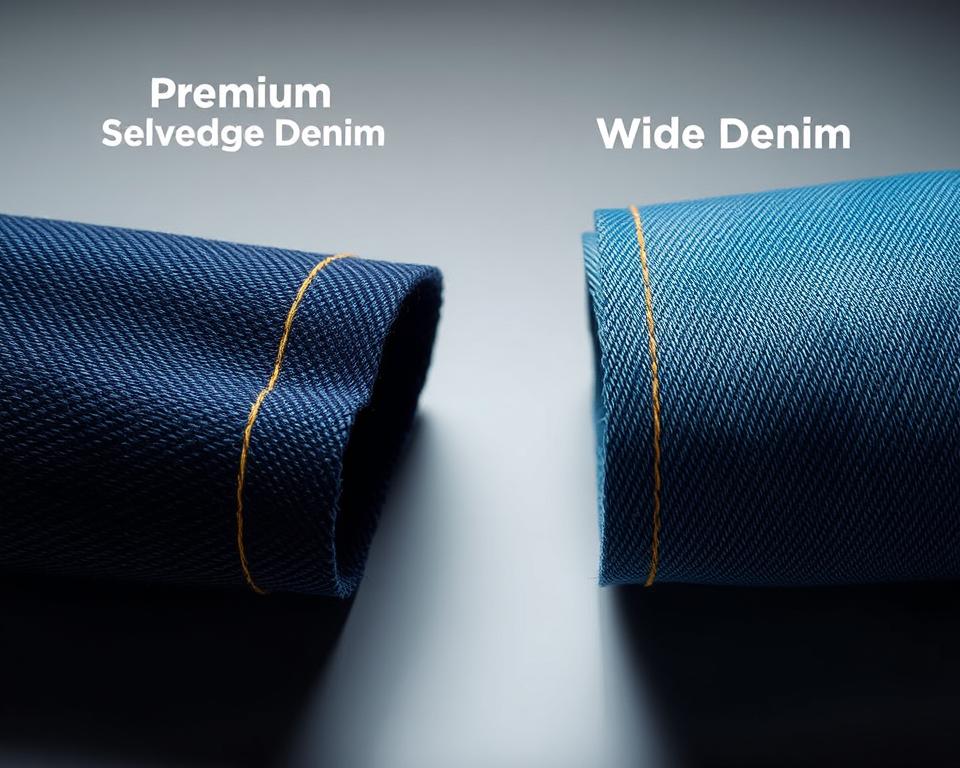A Comprehensive Handbook to Premium denim Selvedge Material
Ever wondered why some pants feel as though they are designed for longevity a lifetime? The secret lies in the elements and craftsmanship. Take, for instance, the growing movement of high-end selvedge. This goes beyond common material—it exemplifies quality and tradition.
Nowadays, a growing number of people are turning to these classic textiles for their durability and iconic selvedge denim by the yard appeal. Whether you’re a home sewing sewist or a denim aficionado, there’s something special about using superior natural fiber and stitching. It’s not just about creating jeans; it involves crafting a legacy.
At Core Fabrics, we’ve curated a range of 14.25oz certified organic cotton and flexible variants. These materials are tailor-made for a spectrum ranging from raw trousers to high-fashion jacket blueprints. Ready to explore the world of top-tier fabrics? Let’s jump right in.
Understanding Denim Selvedge Fabric?
What makes particular trousers distinguish themselves with their distinctive, self-finished edges? The answer is found in the selvedge denim, a premium textile known for its enduring strength and retro charm. Differing from regular textiles, this fabric is crafted with classic methods that have endured through ages.
What Selvedge Denim Means
Selvedge denim is manufactured via retro shuttle looms, which produce narrow widths of about 30-35 inches. These looms weave the fabric in a way that creates self-finished seams, often accented with a signature red line. This method confirms the material is densely interlaced and extremely robust.
Contemporary looms, alternatively, produce expansive material but do not offer the equivalent of craftsmanship. The imperfections in selvedge, like misaligned seams or uneven textures, are accepted as part of its charm. This philosophy, termed “wabi-sabi”, honors the appeal of organic flaws.
The Making of Selvedge Denim
The production of selvedge denim entails a meticulous process. These looms cross the weft thread back and forth, forming a dense and robust fabric. Unlike modern methods with contemporary machines, which emphasize quick production and efficiency over craftsmanship.
Companies such as Karson Denim maintain traditional Japanese craft practices from the 1990s. They purposefully add imperfections to maintain the true character of the material. All products is assessed on a 4-point system, confirming it satisfies the peak requirements of quality.
| Characteristic | Selvedge Denim | Contemporary Denim |
|---|---|---|
| Measure | 30-35 inches | 60+ inches |
| Weaving Process | Shuttle Loom | New-Age Loom |
| Texture | Uneven, Imperfect | Even |
| Sturdiness | Superior | Standard |
“The charm of selvedge resides in its natural irregularities—each irregularity speaks of artistry and heritage.”
The History of Selvedge Denim
Evolving from simple roots to international fame, the story of these fabrics is multifaceted and inspiring. Originally developed as durable workwear in 17th-century France has become a mark of everlasting fashion and craftsmanship.
Historical Roots
The foundation of this textile trace back to Nîmes, France, where it was dubbed “serge de Nîmes.” First intended for laborers, it was constructed with robust cotton and yarn. Its durability made it a favorite among laborers during the historic Gold Rush.
During the twentieth century, it had transformed into a staple for pants. The shuttering of the Cone Mills White Oak factory became a pivotal moment. This shift paved the way for Japanese craftsmen to revive classic fabric-making practices.

Advancements in Production
Following WWII, Japan embraced retro American culture. Skilled workers restored old looms to produce genuine reproductions. This commitment to quality ensured the continuance of selvedge as a unique product.
In modern times, advancements from Italy and Turkey have launched sustainable combinations and flexible selections. These improvements have enhanced the appeal of this classic fabric. Here at Core Fabrics, we procure internationally, from Montréal to Asia, to deliver to you the best standards.
“Selvedge’s story is a celebration of the enduring value of craftsmanship and legacy.”
Reasons to Select Selvedge Denim?
Why does selvedge denim distinguish itself in the universe of premium textiles? Its special characteristics and incomparable robustness make it a favorite among aficionados and creatives alike. Be it that you are crafting jeans or a sharp jacket, this material provides a fusion of classic methods and modern appeal.
Characteristic Features of Selvedge
Selvedge denim is celebrated for its tight weave, which improves tear resistance and color fading characteristics. In contrast to common fabrics, rainbow selvedge denim is fashioned using time-honored shuttle looms, creating a tightly packed and extra robust product. In doing so, it secures that each piece has a distinct surface and personality.
Here’s what makes it special:
- Textured, firm raw denim offers a contrast to laundered, relaxed stretch options.
- Sanforization stabilizes the fabric for consistent measurements, while natural variants entail a unique shrinkage journey.
- Available weights span from 9.5oz Eco Finish to 14.25oz Organic, catering to varied requirements.
Sturdiness and Lifespan
One of the key attributes of selvedge denim is its long life. The firm interlacing boosts robustness while enabling distinctive color fades over time. This renders it a wise purchase for those looking for classic garments.
Key points to consider:
- 12-14oz weights are ideal for structured jackets and jeans that soften with age.
- For classic jean longevity, the 14.25oz True Indigo is a top recommendation.
- Eco-friendly options, like recycled cotton and indigo blends, add sustainability to your wardrobe.
Core Fabrics offers an assortment of products tailored for every requirement. Whether untreated or sanforized, every item is made to provide outstanding quality and performance.
Comparing Selvedge and Wide Denim
For making long-lasting and trendy pieces, the choice of material plays a crucial role. Two popular options are selvedge and wide denim, each with unique characteristics. Understanding their differences can help you choose the right one for your project.
Contrasting Weave Techniques
Selvedge denim is crafted with classic shuttle looms, yielding narrow widths of 30-35 inches. This selvedge denim jacket technique creates firm borders, often marked by a distinctive red line. In contrast, wide denim is produced using modern projectile looms, producing widths of 60 inches or more.
Old-style shuttle looms yield roughly 3m per minute, while modern projectile looms reach speeds of 30 meters per minute. Such speed differences influence both the expense and the finish of the end result.
Pros and Cons of Each Type
Selvedge denim is renowned for its high-end construction and robustness. Its limited breadth renders it perfect for projects where defined edges and detail work are sought. However, it can be more expensive, typically around $23 per meter.
Wide denim is more cost-effective, typically costing $8 per half-meter. Its expansive dimension minimizes excess, ideal for big-scale works like interior décor projects. However, it does not feature the signature finished border of selvedge.
| Characteristic | Selvedge Denim | Wide Denim |
|---|---|---|
| Measurement | 30-35 inches | 60+ inches |
| Weaving Process | Classic Shuttle Loom | Projectile Loom |
| Output | 3 meters per minute | 30m/min |
| Cost | $23/meter | $8/half-meter |
When precise, structured edges are required—as in Grainline Thayer jackets—selvedge wins out. In contrast, wide denim provides cost-effectiveness and speedy production. Weigh your requirements carefully to decide.
Working with Selvedge Denim
Working with premium materials can elevate your sewing projects to the next level. Be it making pants, outerwear, or dresses, knowing how to measure, sew, and care for the material secures expert outcomes. Let’s explore how to make the most of this classic material.
Yardage Needed for Jeans and Jackets
It is essential to compute the correct fabric amount when designing your creation. For men’s jeans, you’ll need about 3-3.3 yards, accounting for potential defects and shrinkage. Trucker jackets typically require 3.3 yards, while skirts require only 2 yards.
Creative pattern placement can help manage imperfections in the material. Rather than avoiding imperfections, incorporate them into your pattern for distinctive style.
| Project | Required Yardage |
|---|---|
| Male Jeans | 3 to 3.3 yards |
| Work Jacket | 3.3 yards |
| Skirt | 2 yards |
Advice for Sewing and Longevity
Using the right tools and techniques ensures a polished result. Select #70 to 110 needles and foot accessories made for robust textiles. For contrast stitching, Gütermann rPET thread is a reliable choice.
Here are some additional tips:
- Use a tailor’s clapper for sharp creases without shine.
- Our denim kits from Core Fabrics comprise topstitch thread, rivets, and 9mm jeans buttons to ensure a refined result.
- Structured edges, essential for jackets, are best achieved with selvedge.
Maintaining your pieces properly increases their longevity. Wash sparingly and air dry to maintain the material’s integrity. Adhering to these practices will sustain your creations for years.
To Conclude
Working with high-end textiles is not solely about longevity; it’s about infusing character. Selvedge denim embodies this philosophy, merging handcrafted appeal with robust strength. From jeans to tailored jackets, every stitch of this material conveys a narrative.
At Core Fabrics, we make it easy to explore your creativity. Our swatch service lets you touch and test the fabric before deciding. Additionally, benefit from complimentary shipping on orders exceeding $150 USD throughout North America.
Looking ahead, eco-friendly blends and vintage washes are shaping the future of cotton textiles. These trends offer new ways to add sustainability and style to your wardrobe.
Eager to explore top-tier textiles? Start shopping today to experience purposeful design. Your future project might just be that lasting masterpiece.


